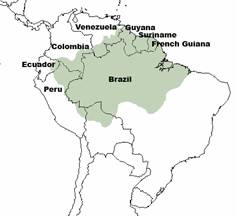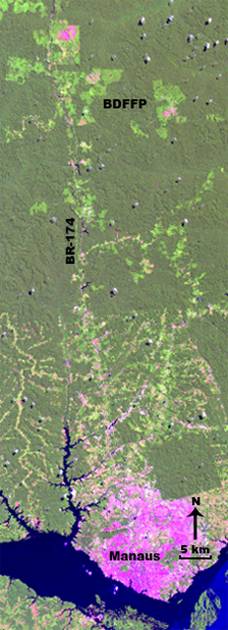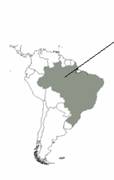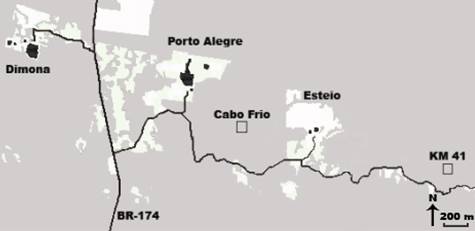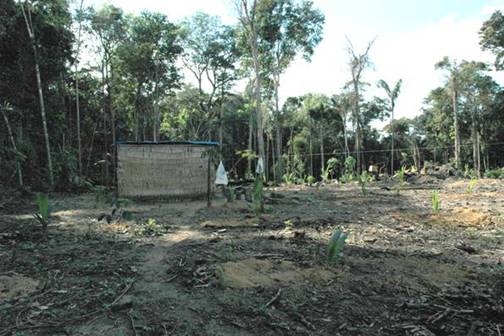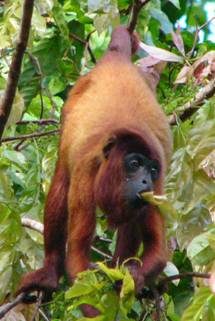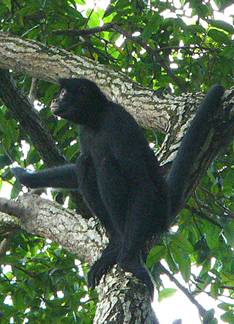
|
|
|
Conservation Letter
Human impacts on primate conservation in central AmazoniaSarah A. Boyle1,2 1Arizona State University, School of Life Sciences, PO Box 4601, Tempe, Arizona, 85287-4601 2Biological Dynamics of Forest Fragments Project, Instituto Nacional de Pesquisas da Amazônia and Smithsonian Tropical Research Institute, Av. André Araújo 1753 Petrópolis, Manaus AM 69011-970, Brazil. E-mail: [email protected]
Received: 19 December, 2007, Accepted: 10 February, 2008, Published: 3 March, 2008 Copyright: This is an open access paper. We use the Creative Commons Attribution 3.0 license http://creativecommons.org Cite this paper as: Boyle, S. A. 2008. Human impacts on primate conservation in central Amazonia. Tropical Conservation Science 1 (1):6-17. Available online: tropicalconservationscience.org Introduction The world's forests are disappearing at a rate of 130,000 square kilometers per year [1]. One of the major centers of deforestation is the Amazon Basin, an area that encompasses portions of Brazil, Bolivia, Peru, Ecuador, Colombia, Venezuela, Guyana, Suriname, and French Guiana (Fig. 1). The Amazon is the world's largest rain forest, with approximately 50% of its area (4,100,000 square kilometers) located in Brazil [2]. Intensive deforestation of the Brazilian Amazon began in the 1970s, and 70% of the clearing can be attributed to medium-sized and large cattle ranches [3, 4]. Additional clearing for soybean agriculture [4] and selective logging practices [5, 6] have further reduced the amount of intact forest. Activity is primarily concentrated in the "arc of deforestation," located in the southern and eastern areas of the Brazilian Amazon [3], but new highway development plans [4] and colonization projects [7, 8] threaten to increase deforestation across the Amazon.
Although there is a body of literature examining the effects of forest fragmentation on fauna, flora, climate, and ecological processes, to date there is no consensus as to which factors are primarily responsible for influencing a species' response to forest fragmentation [19-21]. Furthermore, data are lacking for many taxa. For example, in the primate literature the majority of the behavioral ecology research in disturbed habitats focuses on a handful of species, such as howler monkeys (genus Alouatta) [16, 22, 23]. Thus, conclusions regarding how primates are affected by habitat fragmentation may not be applicable to underrepresented species in the literature due to differences in the species' behavior and ecology. Current human practices throughout the tropics threaten the future research and understanding of little-studied taxa, as well as the species' conservation. In this article I illustrate how recent development plans in the Brazilian Amazon may affect the conservation of the nonhuman primates in the region both directly (i.e., deforestation, hunting) and indirectly (i.e., loss of scientific knowledge). Overview of Conservation Issue
The region surrounding a third highway, BR-174 (Manaus-Boa Vista), which leads to Venezuela (Fig. 2), is the focal area for a controversial plan by the Brazilian federal agency Superintendência da Zona Franca de Manaus (SUFRAMA). The plan calls for at least six colonization projects that would bring 180 families into an area alongside the BR-174, as well as feeder roads such as ZF-3 [7, 8]. The colonization sites would be located approximately 80 km north of Manaus, a large city of approximately 1.6 million inhabitants [29]. Such a project would threaten federally protected areas, a portion of the planned Central Amazonia Conservation Corridor, important research sites operated by the Instituto Nacional da Pesquisas de Amazônia (INPA) and Large Scale Biosphere-Atmosphere Experiment in Amazonia (LBA), and the existence of the Biological Dynamics of Forest Fragments Project (BDFFP), the longest-running study on forest fragmentation [7]. The BDFFP, operated by INPA and the Smithsonian Tropical Research Institute, began in 1979 and has resulted in approximately 600 publications, books, dissertations, and theses by Brazilian and foreign scientists and students on the consequences of forest fragmentation [7]. Gascon and Bierregaard, Jr. [30] and Gascon et al. [31] provide a history of the project and a review of the research findings. The study site (Fig. 3), occupies an area of 1,000 square kilometers, and is in the midst of the area slated by SUFRAMA for the colonization projects, even though sections of the BDFFP study area are national protected areas [7, 8]. Already there has been an influx of human inhabitants to the study area (Fig. 4), and BDFFP has suffered from theft, intentional fires, hunting, and logging [7]. Six primate species reside in the BDFFP study area: red howler monkey (Alouatta seniculus), black spider monkey (Ateles paniscus), brown capuchin monkey (Cebus apella), brown bearded saki (Chiropotes satanas chiropotes) [1], white-faced saki monkey (Pithecia pithecia), and golden-handed tamarin (Saguinus midas). Although research at BDFFP has been ongoing since 1979, primate research in the forest fragments has been sporadic, with in-depth behavioral and ecological research only on red howler monkeys [35-40], white-faced saki monkeys [41-43], and bearded saki monkeys [44]. Therefore, there is still much to learn regarding the responses of the primates to forest fragmentation.
Discussion SUFRAMA's colonization plan to bring in 180 families to the area has raised serious concern by scientists who foresee the plan having negative ecological, economical, and sociological consequences [7, 8]. Agricultural projects in the Amazon are often not profitable [4], due to the area's low soil fertility. Ranchers near the BDFFP's forest fragments have experienced this firsthand [45]. In fact, one of the main uses of forest in central Amazonia is burning it for charcoal (W. Laurance, pers. comm.). Therefore there is concern that the colonists would not benefit from the colonization plan [8], and there would be increased rates of hunting, logging, and charcoal production. In addition, it is important to note that the plots of land in the SUFRAMA settlement areas would be sold to landowners, some for the purpose of weekend leisure; thus, the settlers are not currently homeless (R. Luizão, pers. comm.).
The BDFFP is a unique and valuable resource for the study of primates and forest fragmentation. First, censuses of the primates occurred prior to the isolation of the forest fragments, and subsequent censuses of the forest fragments have been intermittently conducted throughout the past three decades [47-50]. These data are imperative to determine the current status of the resident primate populations, to document any patterns of primate immigrations and extinctions that have arisen during the past 30 years, and to relate the presence or absence of the species to predictive variables (e.g., fragment size, distance to continuous forest, and condition of the matrix). Second, the variations in fragment size (1-100 ha) and the configurations of fragments within the surrounding matrix (which varies from pasture to tall secondary growth forest) allow researchers to study the species within the fragments, as well as their use, or avoidance, of the surrounding landscape. Third, the primates at BDFFP represent six species that vary in body size, diet, home range size, and social structure. Therefore, comparisons of the responses of the species to fragments of various sizes and surrounded by various compositional matrices, are unique opportunities. The findings to-date have shed light on the variability in responses of the six resident primate species to forest fragmentation (Table 1). Differences between species were apparent upon the initial isolation of the BDFFP forest fragments [47]. Furthermore, since the 1980s, some species (e.g., red howler monkey) have persisted in the various forest fragments, while other species (e.g., black spider monkey, Fig. 5) have remained absent from the majority of the forest fragments [47-50]. Understanding why some species are re-colonizing the forest fragments decades later, and how their use of the fragments' resources differs from that of animals living in continuous forest, is critical for the conservation planning of the species. Table 1 Primate Presence 2003-2006. The presence of the six primate species is noted for the three size classes of forest fragments: 100 ha, 10 ha, and 1 ha. For each size class, the proportion of fragments in which each species was present is noted. (*) indicates that the species was present in the forest fragment for less than 20 percent of the study.
Implications for Conservation Overall there is a lack of knowledge of the Amazon's fauna and flora [51], including the behavioral ecology of many free-ranging primates [52]. If the SUFRAMA colonization plan is put into effect, it could disturb several major scientific research sites in the area, as well as the Central Amazonian Conservation Corridor. More importantly, an increase in colonists could result in the local demise of many plant and animal species, including many of the primates. Primates are readily hunted in many parts of the tropics, and an influx of settlers to an area would likely bring extra hunting pressure. Human colonization in the eastern Brazilian Amazon has greatly affected the mammal community [53]. All six primate species inhabiting the BDFFP region are hunted in some areas of the Amazon, though hunting pressure varies [54-59]. To preserve biodiversity in areas experiencing human disturbance, it is important to understand how habitat modifications alter species survival over time. For example, primate presence has fluctuated at the BDFFP, thereby creating opportunities to study species that were not present in the forest fragments during the 1980s. Therefore, the continuation of primate research (e.g., censuses, behavioral studies, land cover classifications) at BDFFP is critical to understanding how (and to what extent) the primates use the forest fragments and the surrounding matrix. Unfortunately, the colonization of the area by 180 families, and the subsequent increased human pressure on vulnerable species, is cause for alarm.
There is hope. Researchers and environmental advocates have partnered with like-minded Brazilian agencies to urge SUFRAMA to halt the colonization plans; to release the findings of its 2004 land-use report, which was developed by both SUFRAMA and scientists; and to consult with scientific and research management organizations and government agencies, as well as the public, prior to commencing any forest-colonization plans [7, 8, 60]. As a result of increased media attention regarding the colonization plan, both in Brazil and abroad [7, 8, 60-63], SUFRAMA has temporarily suspended activities related to forest settlement near the BDFFP area (R. Luizão, pers. comm.). Furthermore, reports Luizão, the BDFFP has been invited to submit proposals for funding to develop a formal management plan for both the BDFFP and other regional protected areas. It is crucial that such collaboration and progress continue, due to the importance of the forest that is at risk by the SUFRAMA colonization plan. Acknowledgements R. Luizão, W. Laurance, D. Kabelik, B. Lenz, A. Smith, and two anonymous reviewers provided helpful comments to improve this article. The author's research in Brazil was funded by the Biological Dynamics of Forest Fragments Project/Instituto Nacional da Pesquisas de Amazônia and the Smithsonian Tropical Research Institute, Fulbright/IIE, Margot Marsh Biodiversity Foundation, Primate Conservation, Inc., Organization for Tropical Studies, American Society of Primatologists, and Arizona State University. This is contribution number 500 in the Biological Dynamics of Forest Fragments Project technical series. References [1] FAO. 2007. State of the World's Forests 2007, Food and Agricultural Organization of the United Nations, Rome. 144 pps. [2] Skole, D. and Tucker C. 1993. Tropical deforestation and habitat fragmentation in the Amazon - satellite data from 1978 to 1988. Science 260: 1905-1910. [3] Fearnside, P.M. and Graça P.M.L. 2006. BR-319: Brazil's Manaus-Porto highway and the potential impact of linking the arc of deforestation to central Amazonia. Environmental Management 38: 705-716. [4] Fearnside, P.M. 2007. The fractured landscape. The American Prospect 18: A11-A13. [5] Asner, G.P., Knapp D.E., Broadbent E.N., Oliveira P.J.C., Keller M. and Silva J.N. 2005. Selective logging in the Brazilian Amazon. Science 310: 480-482. [6] Asner, G.P., Broadbent E.N., Oliveira P.J.C., Keller M., Knapp D.E. and Silva J.N.M. 2006. Condition and fate of logged forests in the Brazilian Amazon. Proceedings of the National Academy of Sciences of the United States of America 103: 12947-12950. [7] Laurance, W.F. and Luizão R. 2007. Driving a wedge into the Amazon. Nature 448: 409-410. [8] Blumberg, J. 2007. Up in smoke. Smithsonian Magazine 38: 31. [9] Lovejoy, T.E. 2006. Protected areas: a prism for a changing world. Trends in Ecology & Evolution 21: 329-333. [10] Bierregaard Jr., R.O., Lovejoy T.E., Kapos V., Dossantos A.A. and Hutchings R.W. 1992. The biological dynamics of tropical rain-forest fragments. Bioscience 42: 859-866. [11] Achard, F., Eva H.D., Stibig H.J., Mayaux P., Gallego J., Richards T. and Malingreau J.P. 2002. Determination of deforestation rates of the world's humid tropical forests. Science 297: 999-1002. [12] Malcolm, J.R. 1997. Biomass and diversity of small mammals in Amazonian forest fragments, In: Tropical Forest Remnants: Ecology, Management, and Conservation of Fragmented Communities, p. 207-221, (ed) W.F. Laurance and R.O. Bierregaard Jr. University of Chicago Press: Chicago. [13] Laurance, W.F., Delamonica P., Laurance S.G., Vasconcelos H.L. and Lovejoy T.E. 2000. Conservation - Rainforest fragmentation kills big trees. Nature 404: 836-836. [14] Asquith, N.M., Wright S.J. and Clauss M.J. 1997. Does mammal community composition control recruitment in neotropical forests? Evidence from Panama. Ecology 78: 941-946. [15] Chapman, C.A. and Onderdonk D.A. 1998. Forests without primates: Primate/plant codependency. American Journal of Primatology 45: 127-141. [16] Estrada, A., Anzures A. and Coates-Estrada R. 1999. Tropical rain forest fragmentation, howler monkeys (Alouatta palliata), and dung beetles at Los Tuxtlas, Mexico. American Journal of Primatology 48: 253-262. [17] Gascon, C., Williamson G.B. and da Fonseca G.A.B. 2000. Ecology - Receding forest edges and vanishing reserves. Science 288: 1356-1358. [18] Laurance, W.F., Vasconcelos H.L. and Lovejoy T.E. 2000. Forest loss and fragmentation in the Amazon: implications for wildlife conservation. Oryx 34: 39-45. [19] Harrison, S. and Bruna E. 1999. Habitat fragmentation and large-scale conservation: what do we know for sure? Ecography 22: 225-232. [20] Kattan, G.H. and Murcia C. 2003. A review and synthesis of conceptual frameworks for the study of forest fragmentation, In: How Landscapes Change: Human Disturbance and Ecosystem Fragmentation in the Americas, p. 183-200, (ed) G.A. Bradshaw and P.A. Marquet. Springer-Verlag: Berlin. [21] Debinski, D.M. and Holt R.D. 2000. A survey and overview of habitat fragmentation experiments. Conservation Biology 14: 342-355. [22] Chiarello, A.G. 1994. Diet of the brown howler monkey Alouatta fusca in a semi-deciduous forest fragment of southern Brazil. Primates 35: 25-34. [23] Silver, S.C. and Marsh L.K. 2003. Dietary flexibility, behavioral plasticity, and survival in fragments: lessons from translocated howlers, In: Primates in Fragments: Ecology and Conservation, p. 251-265, (ed) L.K. Marsh. Kluwer Academic: New York. [24] Laurance, W.F., Cochrane M.A., Bergen S., Fearnside P.M., Delamônica P., Barber C., D'Angelo S. and Fernandes T. 2001. The future of the Brazilian Amazon. Science 291: 438-439. [25] Nepstad, D., Carvalho G., Barros A.C., Alencar A., Capobianco J.P., Bishop J., Moutinho P., Lefebvre P., Silva J., U. L. and Prins E. 2001. Road paving, fire regime feedbacks, and the future of Amazon forests. Forest Ecology and Management 154: 395-407. [26] Fearnside, P.M. 2005. Deforestation in Brazilian Amazonia: history, rates, and consequences. Conservation Biology 19: 680-688. [27] Peres, C.A. and Lake I.R. 2003. Extent of nontimber resource extraction in tropical forests: accessibility to game vertebrates by hunters in the Amazon Basin. Conservation Biology 17: 521-535. [28] Fearnside, P.M. 2007. Brazil's Cuiabá-Santarém (BR-163) Highway: The envirionmental cost of paving a soybean corridor through the Amazon. Environmental Management 39: 601-614. [29] IBGE. 2007. Contagem de População 2007. Instituto Brasileiro de Geografia e Estatística: Rio de Janeiro, 311 pps. [30] Gascon, C. and Bierregaard Jr. R.O. 2001. The biological dynamics of forest fragments project: the study site, experimental design, and research activity, In: Lessons from Amazonia: The Ecology and Conservation of a Fragmented Forest, p. 31-42, (ed) R.O. Bierregaard Jr., C. Gascon, T.E. Lovejoy, and R. Mesquita. Yale University Press: New Haven. [31] Gascon, C., Lovejoy T.E., Bierregaard R.O., Malcolm J.R., Stouffer P.C., Vasconcelos H.L., Laurance W.F., Zimmerman B., Tocher M. and Borges S. 1999. Matrix habitat and species richness in tropical forest remnants. Biological Conservation 91: 223-229. [32] Bonvicino, C.R., Boubli J.P., Otazú I.B., Almeida F.C., Nascimento F.F., Coura J.R. and Seuánez H.N. 2003. Morphologic, karyotypic, and molecular evidence of a new form of Chiropotes (Primates, Pitheciinae). American Journal of Primatology 61: 123-133. [33] Hershkovitz, P. 1985. A preliminary taxonomic review of the South American bearded saki monkeys genus Chiropotes (Cebidae, Platyrrhini), with the description of a new subspecies. Fieldiana 27: 1-46. [34] Silva, J., J. S. and Figueiredo W.M.B. 2002. Revisão sistemática dos cuxiús, gênero Chiropotes Lesson, 1840 (Primates, Pithecidae), in Livro de Resumos: Xth Congresso Brasileira de Primatologia: Amazônia - A Última Fronteira, p. 21, Belém: Sociedade Brasileira de Primatologia. [35] Neves, A.M.S. and Rylands A.B. 1991. Diet of a group of howling monkeys, Alouatta seniculus, in an isolated forest patch in central Amazonia, In: A Primatologia no Brasil, Volume 3, p. 263-274, (ed) A.B. Rylands and A.T. Bernades. Sociedade Brasileira de Primatologia: Belo Horizonte. [36] Gómez, M.S. 2004. The effect of home range reduction on the ecology of red howler monkeys in central Amazonia. Ph.D. dissertation. University of Cambridge, Cambridge. [37] Neves, A.M.S. 1985. Alguns aspectos da ecologia de Alouatta seniculus em reserva isolada na Amazônia Central. B.S. Monograph. Universidade de São Paulo, Ribeirão Preto. [38] Gilbert, K.A. 1997. Red howling monkey use of specific defecation sites as a parasite avoidance strategy. Animal Behaviour 54: 451-455. [39] Gilbert, K.A. 1994. Endoparasitic infection in red howling monkeys (Alouatta seniculus) in the central Amazonian basin. Ph.D. dissertation. Rutgers, New Brunswick. [40] Santamaría, M. and Rylands A.B. 2003. Ecología básica de un grupo de Alouatta seniculus durante una estación seca en la Amazonía central brasilera, In: Primatología del Nuevo Mundo: Biología, Medicína, Manejo y Conservación, p. 96-111, (ed) V. Pereira-Benoga, F.N. Montoya and A. Savage. Centro de Primatologia Araguiatos Ltda: Bogota. [41] Setz, E.F.Z. 1993. Ecologia alimentar de um grupo de parauacus (Pithecia pithecia chrysocephala) em um fragmento florestal na Amazônia Central. Ph.D. dissertation. Universidade Estadual de Campinas, São Paulo. [42] Setz, E.F.Z. 1994. Feeding ecology of golden-faced sakis. Neotropical Primates 2: 13-14. [43] Setz, E.Z.F., Enzweiler J., Solferini V.N., Amêndola M.P. and Berton R.S. 1999. Geophagy in the golden-faced saki monkey (Pithecia pithecia chrysocephala) in the Central Amazon. Journal of Zoology 247: 91-103. [44] Boyle, S.A., Smith A.T., Spironello W.R. and Zartman C.E. in press. The behavioural ecology of bearded sakis (Chiropotes sagulatus) living in forest fragments of central Brazilian Amazonia, In: Evolutionary Biology and Conservation of Titis, Sakis and Uacaris, (ed) A. Barnett, L.M. Viega, S.F. Ferrari, and M.A. Norconk. Cambridge University Press: Cambridge. [45] Bierregaard Jr., R.O. and Gascon C. 2001. The Biological Dynamics of Forest Fragments Project: overview and history of a long-term conservation project, In: Lessons from Amazonia: The Ecology and Conservation of a Fragmented Forest, p. 5-12, (ed) R.O. Bierregaard Jr., C. Gascon, T.E. Lovejoy, and R. Mesquita. Yale University Press: New Haven. [46] Bierregaard Jr, R.O., Laurance W.F., Gascon C., Benitez-Malvido J., Fearnside P.M., Fonseca C.R., Ganade G., Malcolm J.R., Martins M.B., Mori S., Oliveira M., Rankin-De Merona J., Scariot A., Spironello W. and Williamson B. 2001. Principles of forest fragmentation and conservation in the Amazon, In: Lessons from Amazonia: The Ecology and Conservation of a Fragmented Forest, p. 371-385, (ed) R.O. Bierregaard Jr, C. Gascon, T.E. Lovejoy, and R. Mesquita. Yale University Press: New Haven. [47] Rylands, A.B. and Keuroghlian A. 1988. Primate populations in continuous forest and forest fragments in central Amazonia. Acta Amazônica 18: 291-307. [48] Schwarzkopf, L. and Rylands A.B. 1989. Primate species richness in relation to habitat structure in Amazonian rainforest fragments. Biological Conservation 48: 1-12. [49] Gilbert, K.A. 2003. Primates and fragmentation of the Amazon forest, In: Primates in Fragments: Ecology and Conservation, p. 145-157, (ed) L.K. Marsh. Kluwer Academic: New York. [50] Gilbert, K.A. and Setz E.A. 2001. Primates in a fragmented landscape: six species in Central Amazonia, In: Lessons From Amazonia: the Ecology and Conservation of a Fragmented Forest, p. 262-270, (ed) R.O. Bierregaard Jr., C. Gascon, T.E. Lovejoy, and R. Mesquita. Yale University Press: New Haven. [51] Peres, C.A. 2005. Why we need megareserves in Amazonia. Conservation Biology 19: 728-733. [52] Sussman, R.W. 2007. A brief history of primate field studies, In: Primates in Perspective, p. 6-10, (ed) C.J. Campbell, A. Fuentes, K.C. MacKinnon, M. Panger, and S.K. Bearder. Oxford University Press: New York. [53] Lopes, M.A. and Ferrari S.F. 2000. Effects of human colonization on the abundance and diversity of mammals in eastern Brazilian Amazonia. Conservation Biology 14: 1658-1665. [54] Alvard, M.S., Robinson J.G., Redford K.H. and Kaplan H. 1997. The sustainability of subsistence hunting in the Neotropics. Conservation Biology 11: 977-982. [55] de Thoisy, B., Renoux F. and Julliot C. 2005. Hunting in northern French Guiana and its impact on primate communities. Oryx 39: 149-157. [56] Peres, C.A. 2001. Synergistic effects of subsistence hunting and habitat fragmentation on Amazonian forest vertebrates. Conservation Biology 15: 1490-1505. [57] de Souza-Mazurek, R.R., Pedrinho T., Feliciano X., Hilário W., Gerôncio S. and Marcelo E. 2000. Subsistence hunting among the Waimiri Atroari Indians in central Amazonia, Brazil. Biodiversity and Conservation 9: 579-596. [58] Cormier, L. 2006. A preliminary review of Neotropical primates in the subsistence and symbolism of indigenous lowland South American peoples. Ecological and Environmental Anthropology 2: 14-32. [59] Peres, C.A. 1990. Effects of hunting on western Amazonian primate communities. Biological Conservation 54: 47-59. [60] ATBC. 2007. Resolution Supporting Conservation of Critical Ecosystems and Research Sites in Central Amazonia. [61] Mongabay.com. 2007. Scientists demand Brazil suspend Amazon colonization project. Mongabay.com. news.mongabay.com/2007/0827 [62] Leite, M. 2007. O gringo, a floresta e a escória. Folha do Meio Ambiente (Online). folhadomeio.com.br/publix/fma [63] Lopes, M. 2007. Pesquisadores contra assentamento da Suframa. Folha do Meio Ambiente (Online). folhadomeio.com.br/publix/fma Comments Reader comments are generally moderated. If you find something inappropriate, please contact Tropical Conservation Science. The opinions expressed in reader comments are those of the author only, and do not necessarily reflect the opinions of other authors or Tropical Conservation Science. |
 |
Tropical Conservation Science is an open-access e-journal that publishes research relating to conservation of tropical forests and other tropical ecosystems.
Volume 1: Issue 1 Table of Contents Articles PDF version General interest review All issues Mar 2008 Jun 2008 Sep 2008 Dec 2008 Mar 2009 Jun 2009 Sep 2009 Dec 2009 Mar 2010 Jun 2010 Sep 2010 Dec 2010 Mar 2011 Jun 2011 Sep 2011 Dec 2011 Mar 2012 Jun 2012 Sep 2012 Dec 2012 Mar 2013 Jun 2013 Aug 2013 Sep 2013 Nov 2013 Dec 2013 Mar 2014 Jun 2014 Sep 2014 Dec 2014 Mar 2015 Jun 2015 Sep 2015 Dec 2015 Mar 2016 Jun 2016 Most downloaded 2008 2009 2010 2011 2012 All time ADVERTISEMENT SEARCH  This work is licensed under a Creative Commons Attribution-NonCommercial-NoDerivatives 4.0 International License. |
|||||||||||||||||||||||||||||||||||||||||||||||
|
About | Privacy Copyright mongabay.com 2008-2014 |
